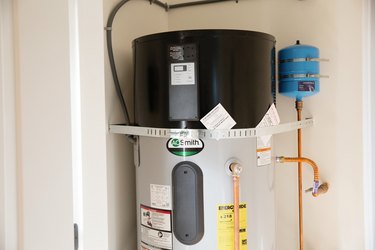Draining a water heater is something you should do once a year to keep your hot water heater running smoothly. The draining process is quick, usually no more than 15 minutes, depending on the size of your tank, but prep work takes a bit longer, and the whole process may require about a day.
Tip
Expect to spend several hours or a day to completely drain your water heater. If you have hard water, you may want to flush your water heater twice a year or more. If you have a water softener, you should drain your tank at least once a year to get rid of calcium and magnesium buildup.
Video of the Day
Preparing to Drain Water Heater
If your water heater is clogged, you'll need to drain it as soon as you can to provide your household with hot water. If not, make sure you drain it once a year, or more often if you have hard water. The first step is to shut off the power to the hot water heater. This is a critical step. If you have a gas water tank, instead of flipping the circuit breaker, you'll turn the gas valve off, onto pilot mode.
Video of the Day
You will need a hose to drain the tank. A hose with a rubber gasket will prevent leaks. If your water heater is below ground level, a hose may work, or you may need a portable pump. In that case, you'll need two hoses, one to connect to the pump and the other to connect outside. If your water heater is at or above ground level, gravity will do the job.
Then, turn off the water going into the tank. Now here's where you're going to use up some time. You will need to let the water cool. This may take a few hours or overnight. Try taking a long, hot shower to speed the process.
Draining the Water Heater
When the water is cool, connect the hose to the drain valve and extend the hose where you can drain it — a garden is not a good idea, because of the sediment. You can use a bucket and empty the bucket as needed, but you'll need to start and stop the process.
Turn off the valve to the cold water supply line. Then, you want to check the pressure relief valve. Place a bucket beneath the valve and listen for air and watch for water. Either of these means the valve is working. If there's no hiss of air or drip of water, this may need to be replaced. Then, turn on a hot water faucet somewhere else in the home as a relief valve to help the water flow out of the tank faster.
Open the water heater drain valve and drain your tank completely. Once the water is drained, which should take no more than 15 minutes, turn on the cold water supply valve to help get rid of the sediment in your tank. This may take a little or a lot of time, depending on the sediment buildup. You may have to pry some of it loose with a long screwdriver. When the water runs clear, you have finished draining.
Finishing the Job
If you have stains on your water heater from the sediment, you may want to clean them. You can use white vinegar to clean out the tank. If the stains are particularly stubborn, you may want to let the vinegar sit for a few hours before draining it as you did the water.
Now it's time to put all the pieces back together. Close the hot drain valve and continue to fill up the tank with cold water. Wait until the tank is full before turning on the electricity or gas.
Your water heater should run more efficiently now that you have cleaned out the sediment, so you will need less power to heat water. Cleaning your water heater annually will help you save on water bills.
